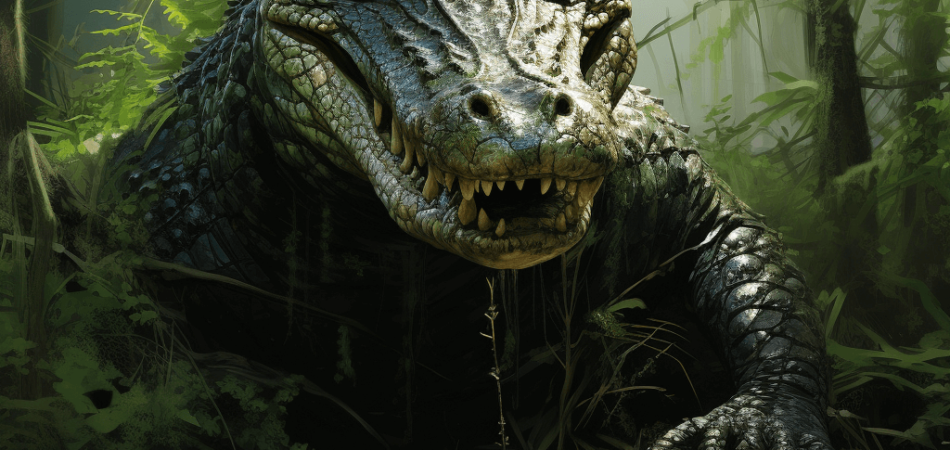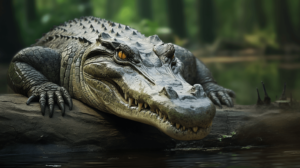Aardonyx Guide:
Aardonyx was an early dinosaur that lived in South Africa about 200 million years ago.
Aardonyx was an early dinosaur that lived in South Africa about 200 million years ago.

Ever wondered if alligators are actually dinosaurs? You’re not alone! This fascinating question has intrigued many people, and we’re here to uncover the truth. Let’s dive into the world of alligators, dinosaurs, and their connection.
Within the vast and diverse animal kingdom, alligators are classified as reptiles, which are cold-blooded vertebrates with scaly skin. Reptiles are an ancient group that includes snakes, lizards, and turtles. But what about dinosaurs? How do they fit into the picture?
Before we jump into the history of alligators and dinosaurs, let’s quickly introduce the two alligator species that exist today. The American alligator (Alligator mississippiensis) is found in the southeastern United States, while the Chinese alligator (Alligator sinensis) is native to the Yangtze River basin in China.
To understand the relationship between alligators and dinosaurs, we must go back to the Mesozoic Era, which spanned from about 252 to 66 million years ago. This era is divided into three periods: the Triassic Period, Jurassic Period, and the Cretaceous period.
The first alligator species emerged around 250 million years ago during the Triassic Period. These ancient reptiles were already well-established when the first dinosaurs appeared.
As we move forward to the Jurassic Period, dinosaurs began to dominate the landscape, becoming the ruling reptiles of the planet. This trend continued into the Cretaceous Period, with many iconic dinosaur species, such as the fearsome Tyrannosaurus rex, roaming the Earth. During this time, a diverse range of dinosaur species evolved, adapting to various environments and niches. Among them was the amazing stegosaurus, known for its distinctive plates and spiked tail, leaving many paleontologists fascinated by its unique anatomy and behaviors. To learn more, enthusiasts often seek out amazing stegosaurus facts to gain a deeper understanding of how these remarkable creatures thrived during the Mesozoic era.

While T-Rex is undoubtedly one of the most well-known dinosaurs, how does it compare to alligators? The mighty T-Rex was a fierce predator that walked on two legs and had a massive skull with powerful jaws. In contrast, alligators are semi-aquatic creatures that walk on four legs and have a more streamlined body shape.
Around 66 million years ago, a mass extinction event wiped out approximately 75% of all species on Earth, including non-avian dinosaurs. So how did alligators manage to survive this catastrophic event? One theory suggests that their semi-aquatic lifestyle and ability to withstand long dormancy periods helped them endure the harsh conditions that followed the mass extinction.
Alligators have changed very little over the past 80 million years, earning them the nickname “living fossils.” This means that modern alligators closely resemble their ancient ancestors, providing a unique glimpse into the past.
While alligators and dinosaurs share a common ancestor, alligators are not technically dinosaurs. Dinosaurs belong to a separate group of reptiles called Archosaurs, including crocodiles and modern birds.
There are several key differences between alligators and dinosaurs. Alligators have a more streamlined body shape, with a broad, flat skull and a powerful, long tail. In contrast, dinosaurs came in many shapes and sizes, from small, bird-like creatures to massive, long-necked giants.
Another difference lies in the way these animals move. Alligators walk on four legs with their limbs sprawled out to the sides, while many dinosaurs walk on two legs with their limbs positioned beneath their bodies. Additionally, alligators are egg-laying creatures, and although dinosaurs also laid eggs, their nesting habits varied greatly between species.
Despite their differences, alligators and dinosaurs share some common traits, such as sharp teeth and scaly skin. Both groups of animals evolved to have sharp, serrated teeth for capturing and tearing apart prey. Scaly skin is another characteristic feature of alligators and dinosaurs, protecting them from the elements.

Alligators are part of the Crocodilia order, including crocodiles, gharials, and caimans. These semi-aquatic creatures share many similarities with alligators, such as their long, powerful tails and sharp teeth.
Modern crocodiles are the closest relatives of alligators. Like alligators, crocodiles have a similar body shape and lifestyle, with some key differences in their snout shape and the placement of their teeth. Despite these differences, both groups of animals are closely related, with a common ancestry dating back to the Mesozoic Era.
Interestingly, birds are considered the closest living relatives of dinosaurs, specifically theropod dinosaurs like the T-Rex. Birds are, in fact, descendants of small, feathered dinosaurs that survived the mass extinction event. This means that alligators are more distantly related to birds than to dinosaurs.
As the Cretaceous Period drew to a close, mammals began to rise in prominence, eventually replacing dinosaurs as the dominant land animals. This shift in the animal kingdom marked the beginning of the Cenozoic Era, which extends to the present day.
Alligators and dinosaurs share a common ancestor that lived around 250 million years ago during the Triassic Period. This ancient reptile is the point of divergence for the two groups, leading to the development of the wide variety of reptiles we see today.
While alligators and dinosaurs share some similarities and a common ancestor, they are not the same. Alligators belong to the Crocodilia order, while dinosaurs are part of a separate group of reptiles called Archosaurs. The fascinating connection between alligators, dinosaurs, and birds provides a captivating glimpse into the complex evolutionary history of Earth’s ancient and modern reptiles.
In conclusion, while alligators and dinosaurs share some similarities and a common ancestor, alligators are not technically dinosaurs. Alligators belong to the Crocodilia order and are more closely related to modern crocodiles and other crocodilians than they are to dinosaurs. Nonetheless, the fascinating connection between alligators, dinosaurs, and birds provides a captivating glimpse into the complex evolutionary history of Earth’s ancient and modern reptiles.

No, alligators are not considered dinosaurs. Although they share a common ancestor, they belong to different groups within the reptile family.
Alligators and dinosaurs share a common ancestor that lived around 250 million years ago during the Triassic Period.
Yes, alligators and dinosaurs coexisted during the Mesozoic Era, which includes the Triassic, Jurassic, and Cretaceous periods.
Yes, birds are the closest living relatives of dinosaurs, specifically theropod dinosaurs, and they share a more distant relationship with alligators.
One theory suggests that alligators’ semi-aquatic lifestyle and ability to withstand long periods of dormancy helped them survive the harsh conditions following the mass extinction event.
Modern alligators are very similar to their ancient ancestors, with only minor differences in size and appearance. They are often referred to as “living fossils” because they have changed very little over the past 80 million years.